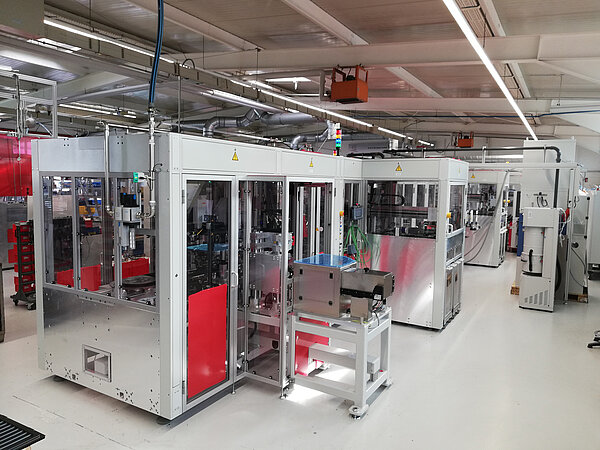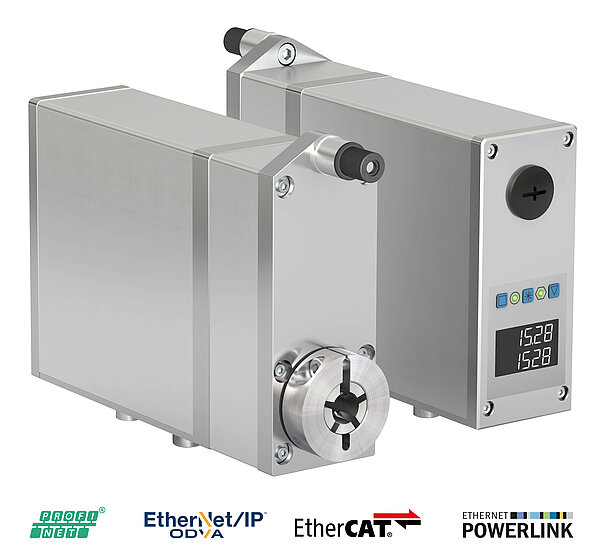Braun Sondermaschinen GmbH relies on high-performance positioning drives from SIKO
Manuel S. Gander, M. Sc., Area Manager of Supply Chain Management and Material Management at Braun Sondermaschinen GmbH, explained the requirements in special-purpose machine manufacturing: "The automated production lines that we implement are developed according to specific and individual customer requirements – usually as a prototype and then as an adapted replicate. No system is like the other; there are always special requirements." To ensure that a certain degree of standardization is still possible, the company provides its modular automation concept: “The Mak system consists of an aluminum crossbeam and a protective enclosure. Depending on customer requirements, the individual processes are connected modularly and a software package is placed over the entire system. Even after years, processes can be exchanged and changed in this construct without redesigning the entire line from scratch.”
Automated format change via positioning drive
One aspect that is also taken into account in system planning is the increased number of variants that machines must be able to handle with the smallest batch sizes. Compact positioning drives enable automated and fast format adjustment without major intervention in PLC programs. The AG24 positioning drives from SIKO are always used at Braun Sondermaschinen GmbH when manual workstations are to be automated that require exact format changes within a line.
One example of this is balancing systems (assembly and balancing machines) for the production of cooling fans for the automotive component supply industry. Previously, balancing was a manual process in which the special machine manufacturer had already used mechanical position indicators from SIKO for manual format adjustment. With the AG24 positioning drive, this module can be converted quickly and precisely for the increasing model variants. Existing manual workstations can also be retrofitted with a SIKO drive thanks to simple assembly via the hollow shaft.
High power reserve for demanding applications
The decision in favor of the SIKO actuator AG24 is based on its high torque and the associated power reserves. This range of services is not always required for systems, but the possibility of reserve plays a major role, for example when components become increasingly sluggish due to contamination and stress and the drive can then provide more power. This also allows the maintenance intervals to be extended if the drive is not constantly running at the load limit.
An alternative to positioning drives are servomotors, which are suitable for most processes, but less so when compactness and manual activities are important. All essential functions such as the brushless DC motor, position sensor or power and control electronics are already integrated in the AG24. It can be connected directly to the machine control unit, is compact and does not require wiring like a servomotor, which requires additional components such as frequency converters or inverters. The positioning drive also has an integrated absolute value transmitter that detects the position at any time even in a de-energized state and does not require referencing.
For Jürgen Schuh, Manager of the Changeover Solutions Business Unit at SIKO, the advantages for a special machine manufacturer such as Braun are also evident: "Each project has a new specification sheet with additional possible variants on the table, which again includes special requirements. With the AG24, Braun Sondermaschinen GmbH has a device in its hands that can serve a wide range of applications in format adjustment thanks to the functional reserve and thus be a standard tool.”
In addition, the drive includes an additional safety function thanks to the optional spring-loaded brake. Even when the brake is de-energized, it keeps the axis in its defined position; this functionality is interesting for vertically positioned spindles that have a certain weight, for example. In the event of a power failure, the weight could push down and the drive could no longer hold it back without a power supply. In this case, the braking force is activated and the brake automatically engages and holds the spindle in place when power is switched off.
Manual adjustment directly on the device
Mr. Gander is convinced by another aspect of the SIKO AG24, which its customers attach great importance to: the possibility of not only controlling the drive via fieldbus and the PLC, but also of being able to use a manual setting option directly on the display of the device via operating keys. In some applications, it makes sense to manually perform the setting and positioning beforehand by means of a teach-in, i.e., to gradually reach the appropriate level with the positioning drive and then store these positions as setpoint values in the machine controller. As a result, the finely adjusted positions can be approached directly during commissioning. The AG24 positioning drive combines both aspects, manual fine adjustment and automated efficient process.
"From an electrical design point of view, the integration of the actuator is also very straightforward, including integration into the machine control system," Mr. Gander stated. "We generally use Ethernet or EtherCAT, but SIKO also has numerous other interface standards in the field of real-time Ethernet as well as corresponding software tools."
Predictive maintenance thanks to diagnostic data
According to Mr. Gander, an aspect that will also gain in importance among its customers in the future is the collection and evaluation of data on the production lines, which is supported by the smart functionality of the AG24 positioning drive. In addition to position determination, the drive can display additional diagnostic data such as current consumption or temperature on the display as well as provide it via the interface. From this, conclusions can be drawn in the sense of predictive maintenance, and maintenance intervals can be planned in advance. The drive thus also supports requirements with regard to Industry 4.0 and data evaluation via AI.
"Full automation becomes standard"
Mr. Gander sees a lot of potential for the future in this diagnostic capability, because his idea of the ideal automation line is "the plant in a dark hall, in which production can take place 24 hours a day, seven days a week, 365 days a year without human intervention". This vision is not far off; human judgments are still mandatory for certain processes, but the more unnecessary, laborious or error-prone process steps can be automated, the more efficiently production can take place. For the special machine manufacturer, it is clear: “Full automation is not only steadily increasing, it is becoming the standard in industrial production.” Intelligent peripheral components such as positioning drives are playing an increasingly important role in this.
Author: Michaela Wassenberg, freelance journalist
Characters: 7,080
Characters with blanks: 8,114





